Abstract
The anti-ulcer drugs that act as covalent inhibitors of the gastric acid pump are targeted to the gastric H+/K+ ATPase by virtue of accumulation in acid and conversion to the active sulfenamide. This results in extremely effective inhibition of acid secretion. Appropriate dosage is able to optimize acid control therapy for reflux and peptic ulcer disease as compared to H2 receptor antagonists. However, clinical data on recurrence show that Helicobacter pylori eradication should accompany treatment of the lesion. These drugs have been found to synergize with many antibiotics for eradication. The survival of aerobes depends on their ability to maintain a driving force for protons across their inner membrane, the sum of a pH and potential difference gradient, the protonmotive force (pmf). The transmembrane flux of protons across the F1F0 ATPase, driven by the pmf, is coupled to the synthesis of ATP. The internal pH of H. pylori was measured using the fluorescent dye probe, BCECF, and the membrane potential defined by the uptake of the carbocyanine dye, DiSC3 [5] at different pHs to mimic the gastric environment. The protonmotive force at pH 7.0 was composed of a delta pH of 1.4 (-84mV) and a delta potential difference of -131mV, to give a pmf of -215 mV. The effect of variations in external pH on survival of the bacteria in the absence of urea correlated with the effect of external pH on the ability of the bacteria to maintain a pmf. The effect of the addition of 5 mM urea on the pmf was measured at different medium pH values. Urea restored the pmf at pH 3.0 or 3.5, but abolished the pmf at pH 7.0 or higher, due the production of the alkalinizing cation, NH3. Hence H. pylori is an acid-tolerant neutrophile due to urease activity, but urease activity also limits its survival to an acidic environment. These data help explain the occupation of the stomach by the organism and its distribution between fundus and antrum. This distribution and its alteration by proton pump inhibitors also explains the synergism of proton pump inhibition and antibiotics such as amoxicillin and clarithromycin in H. pylori eradication.
Full text
PDF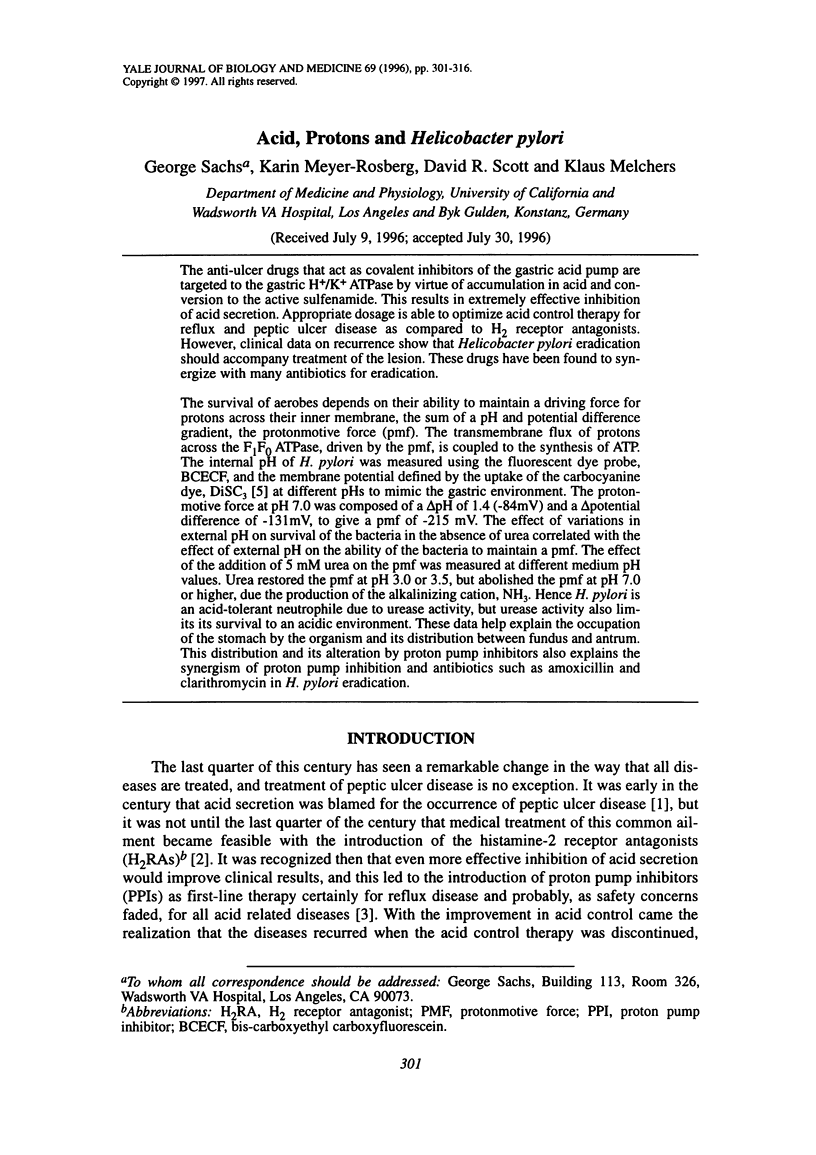
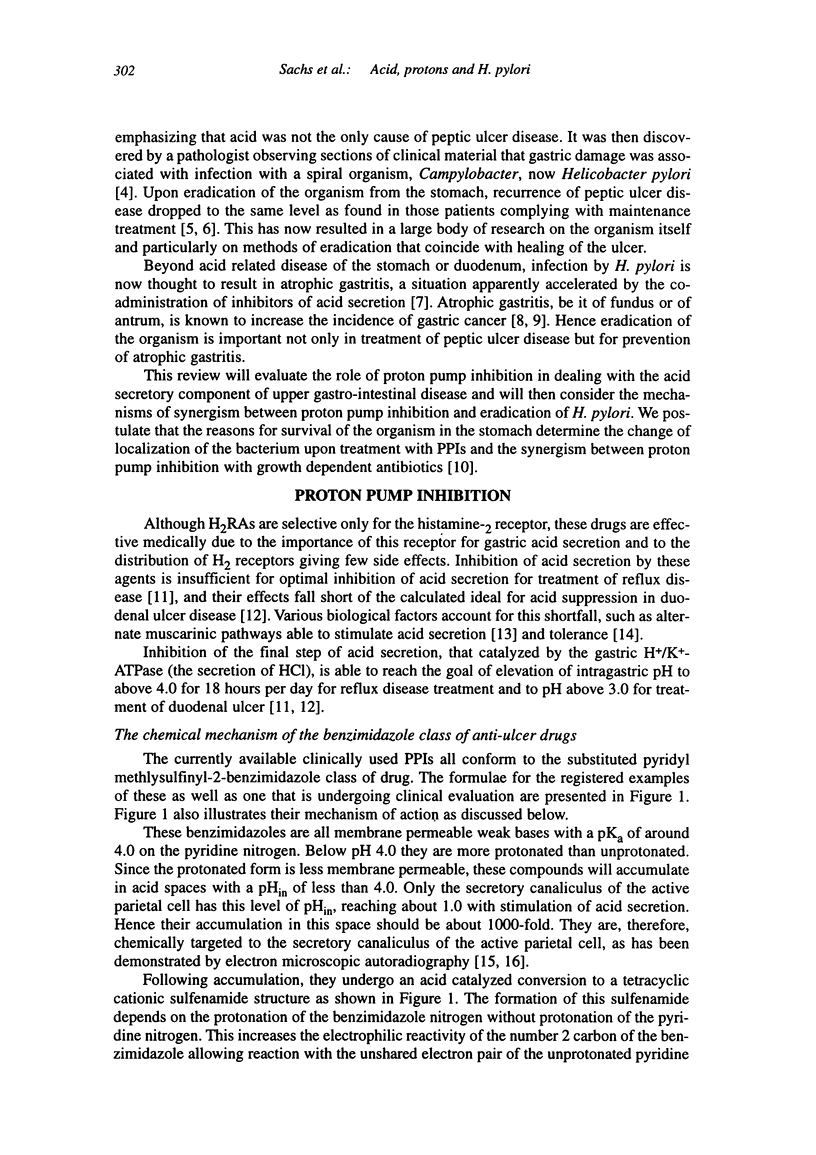

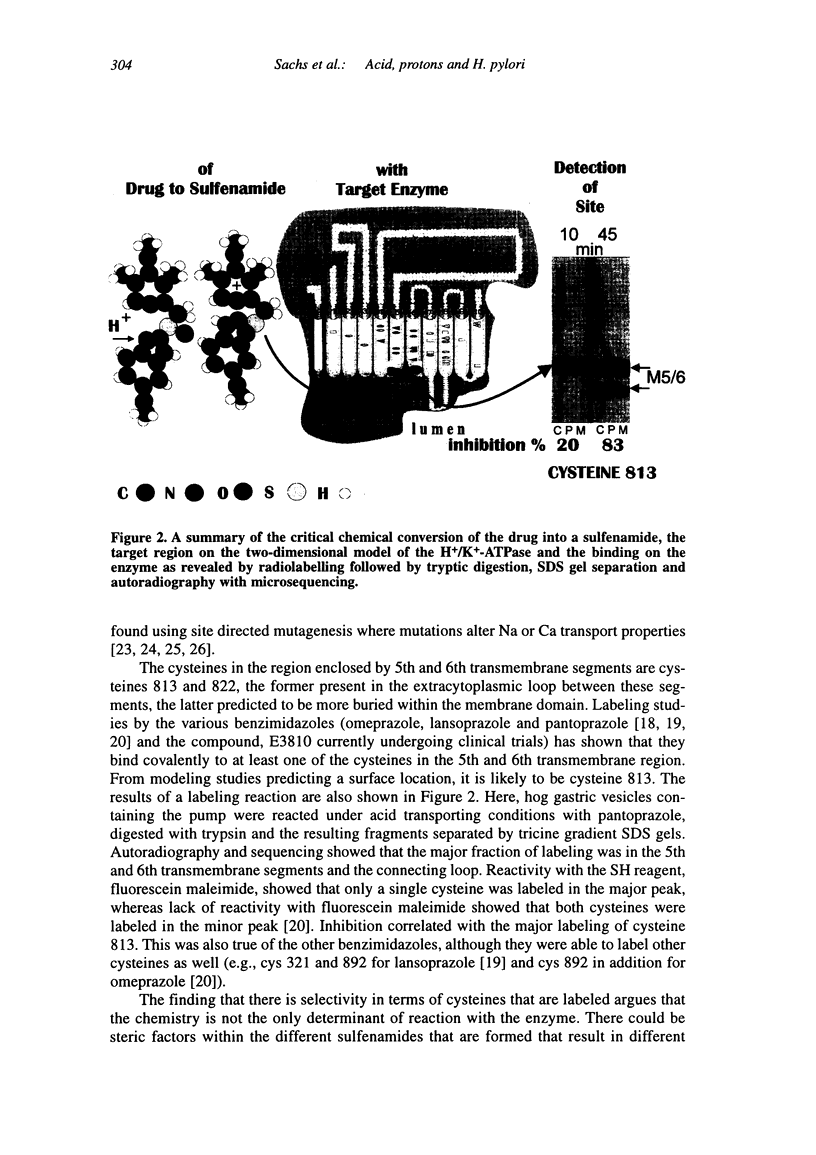
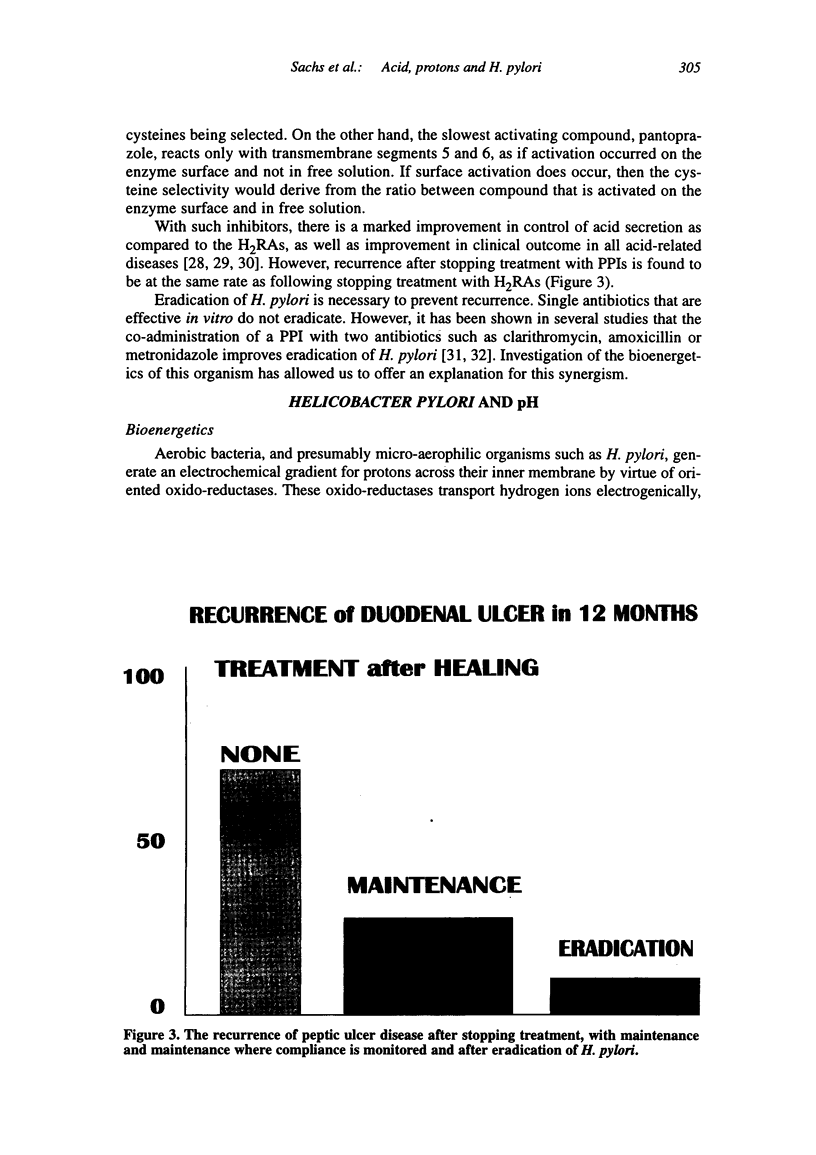
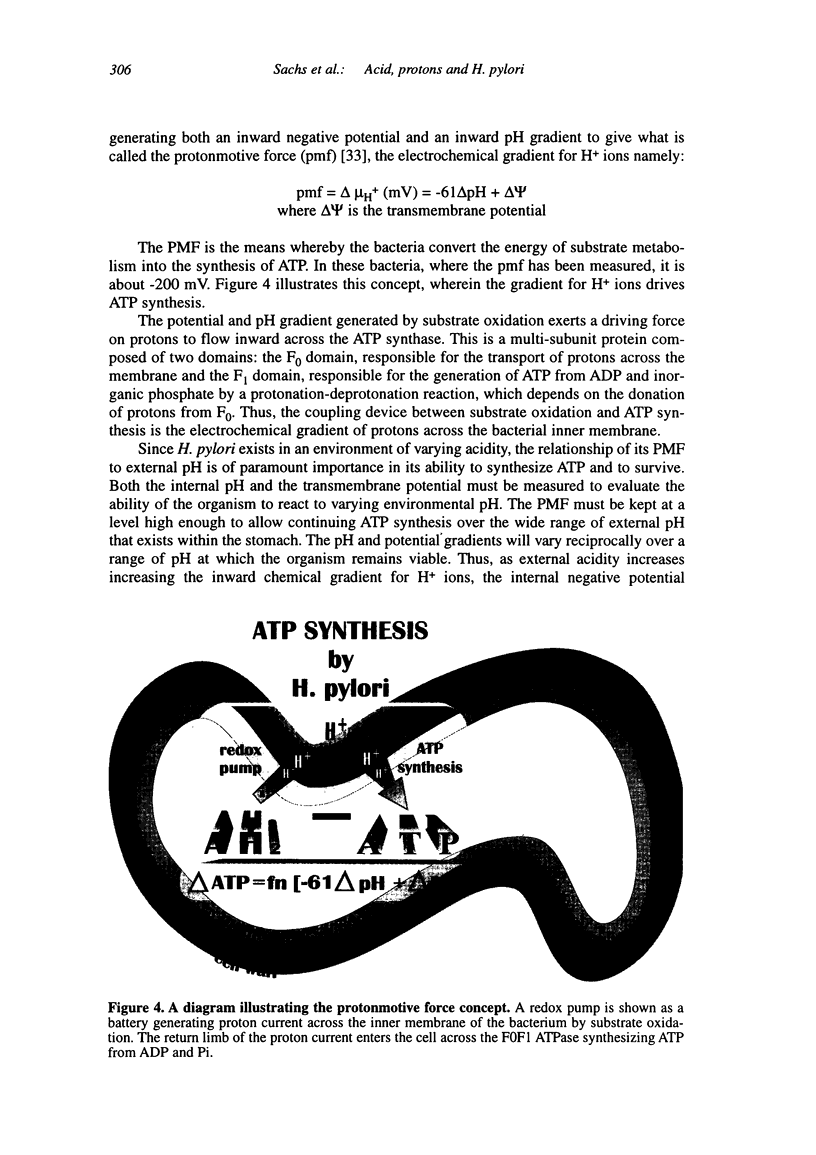
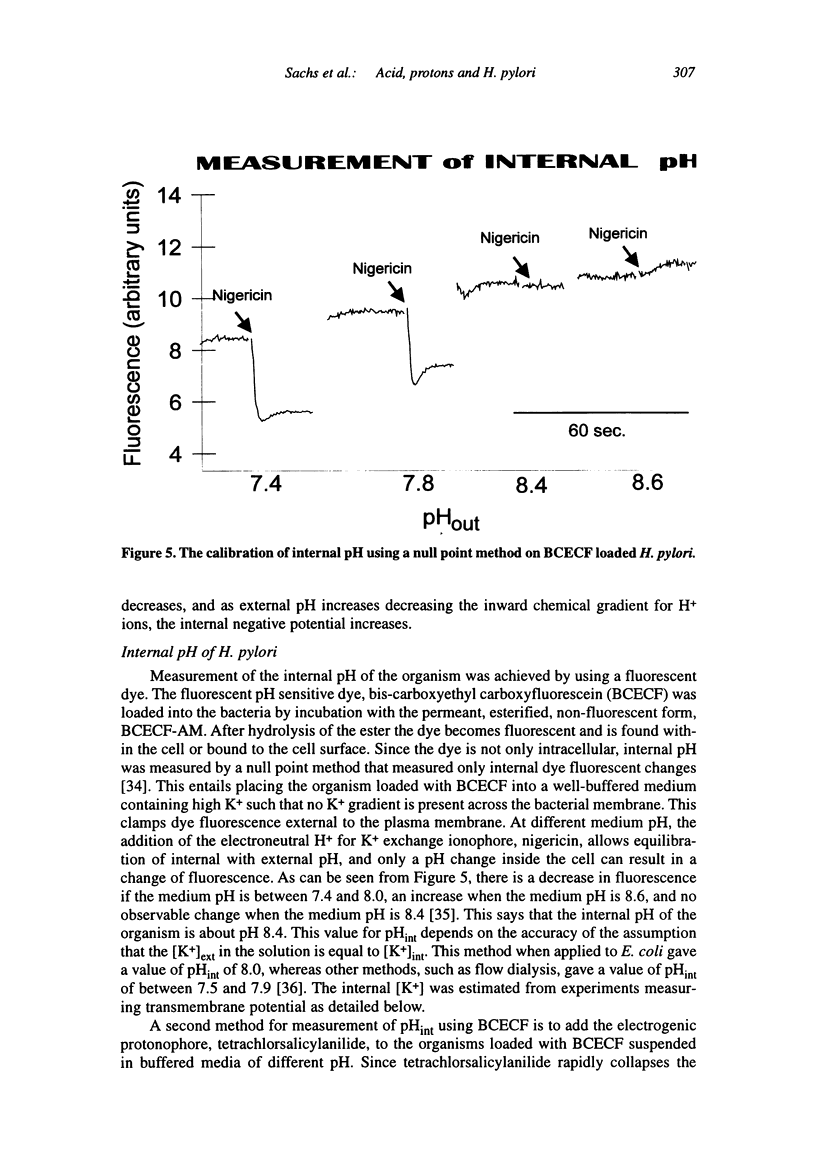
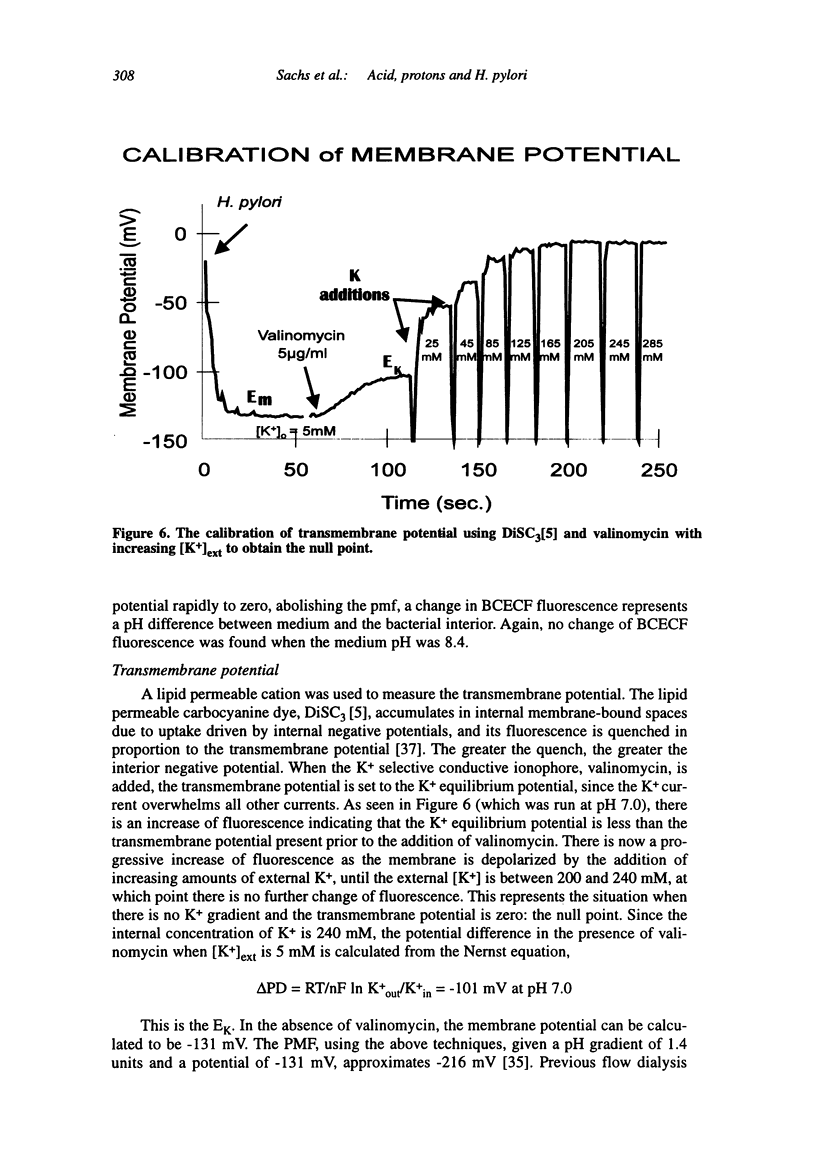
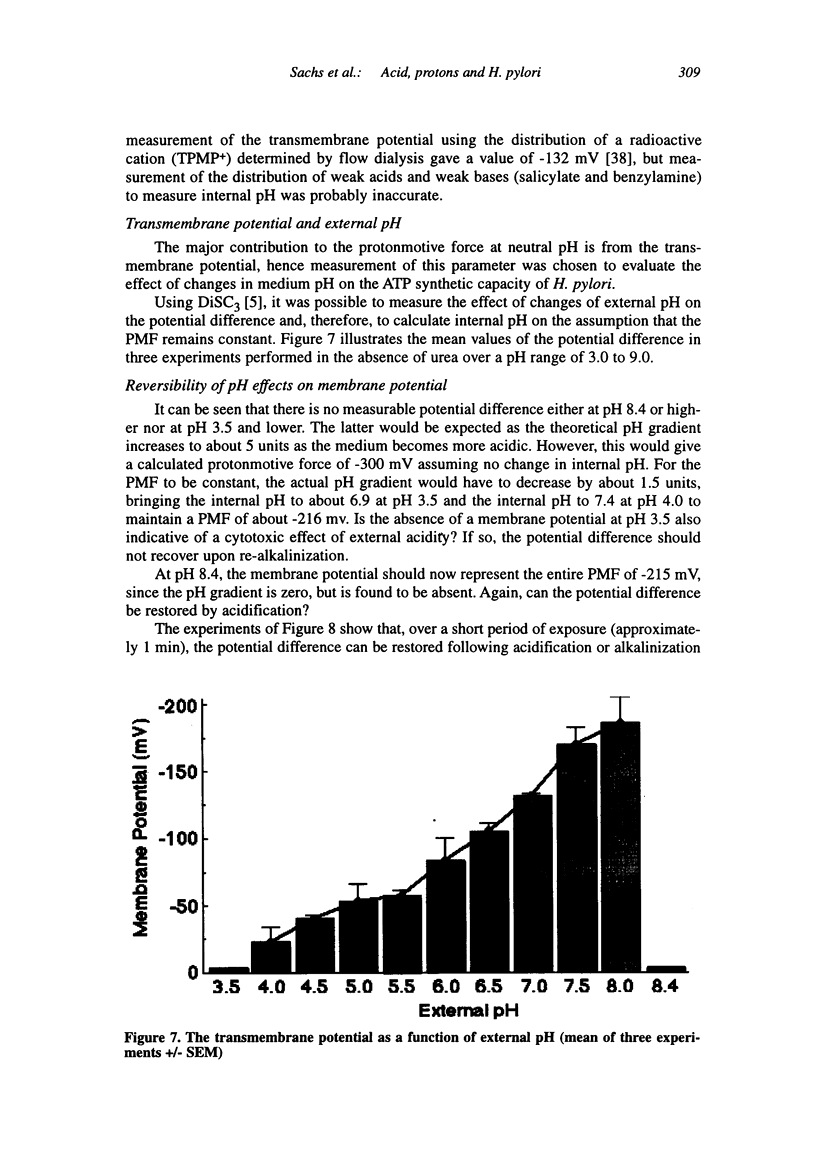
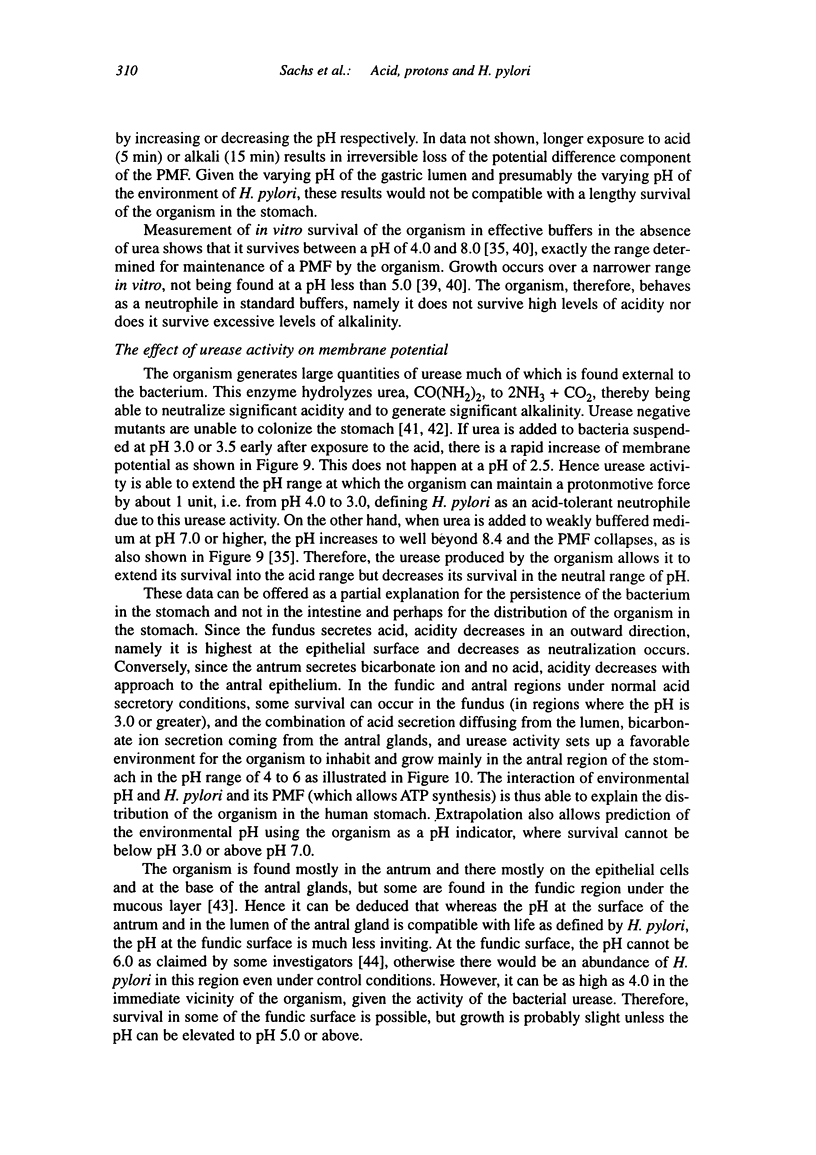
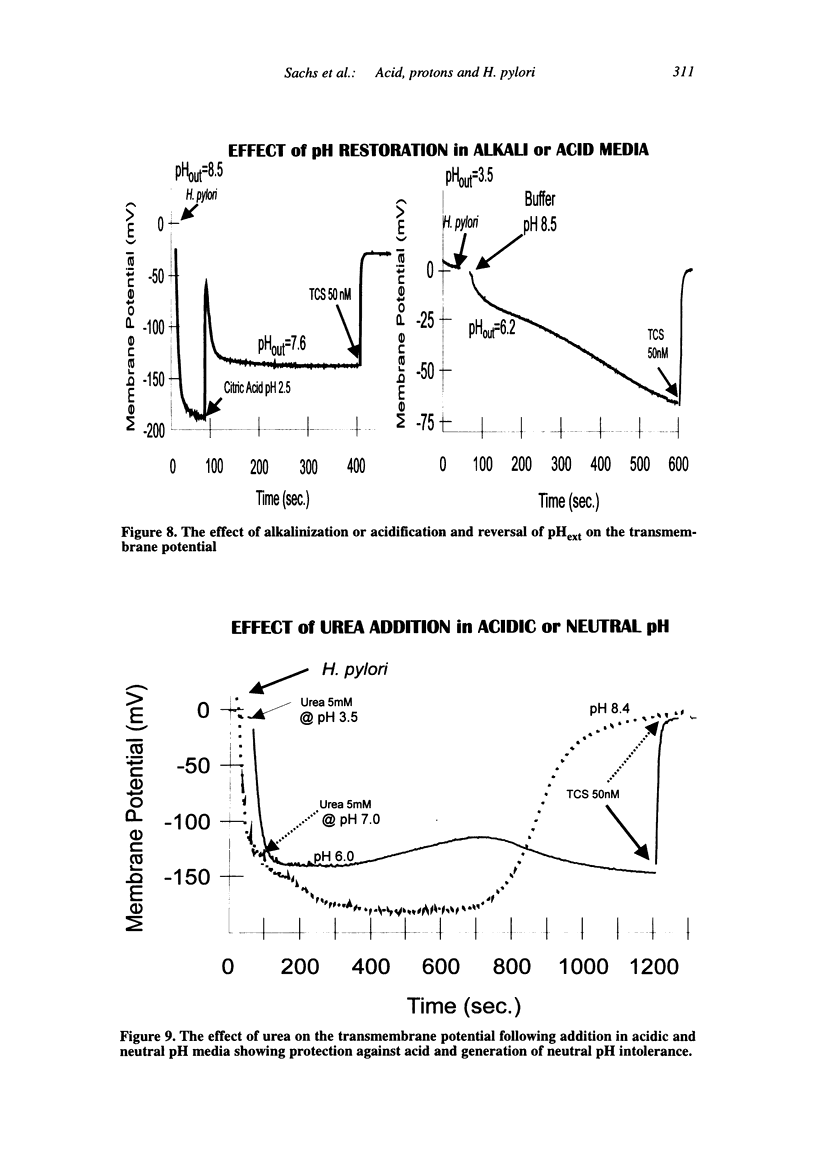
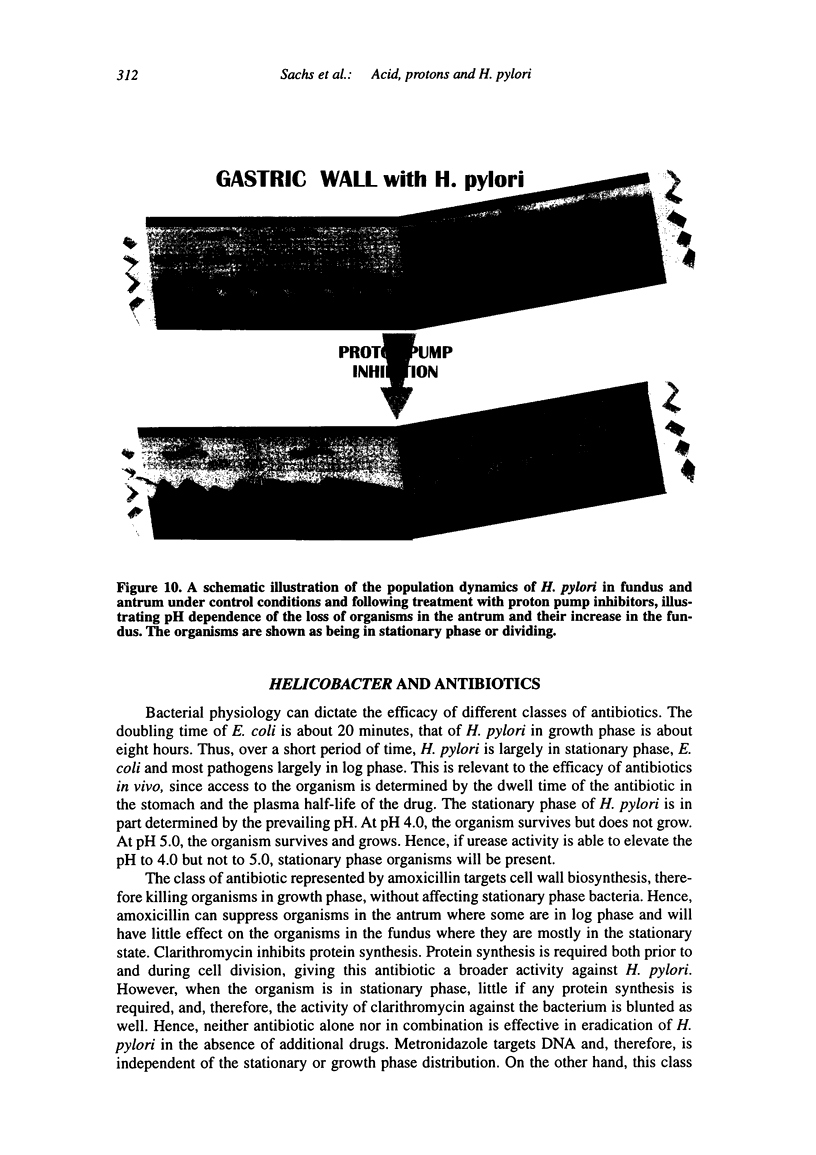
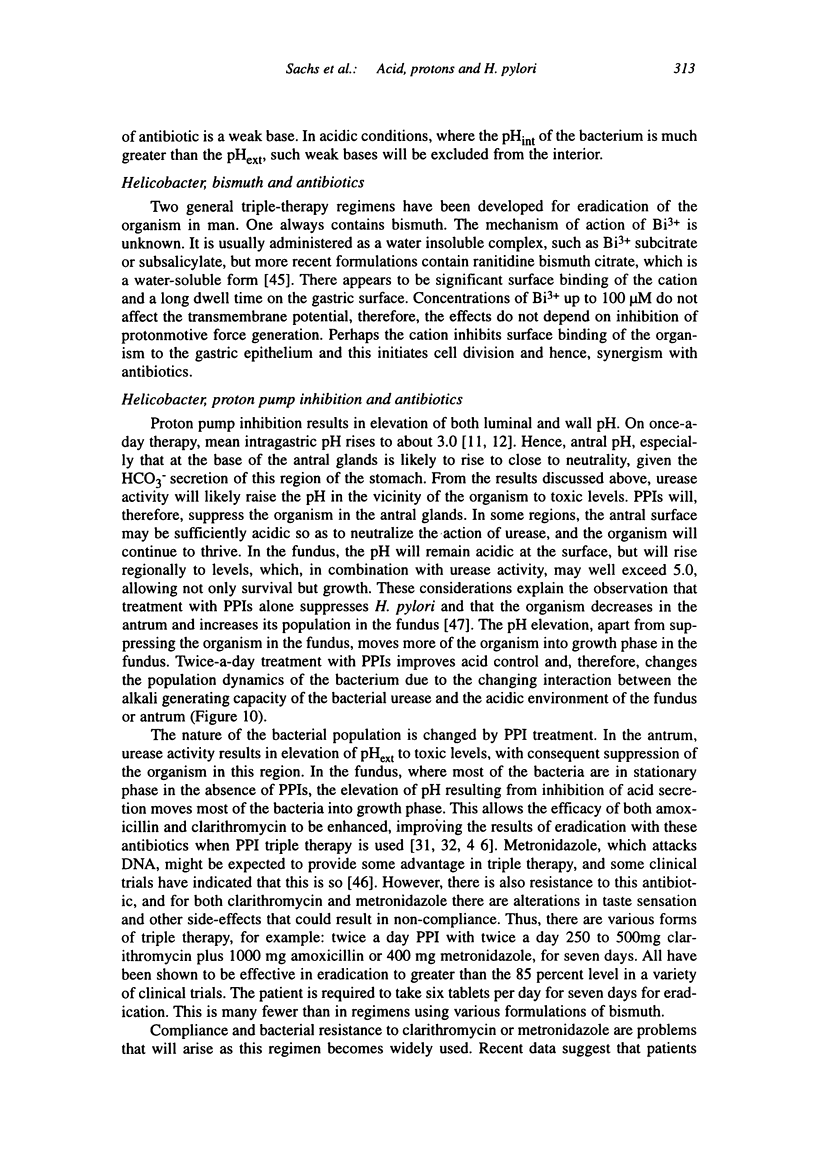
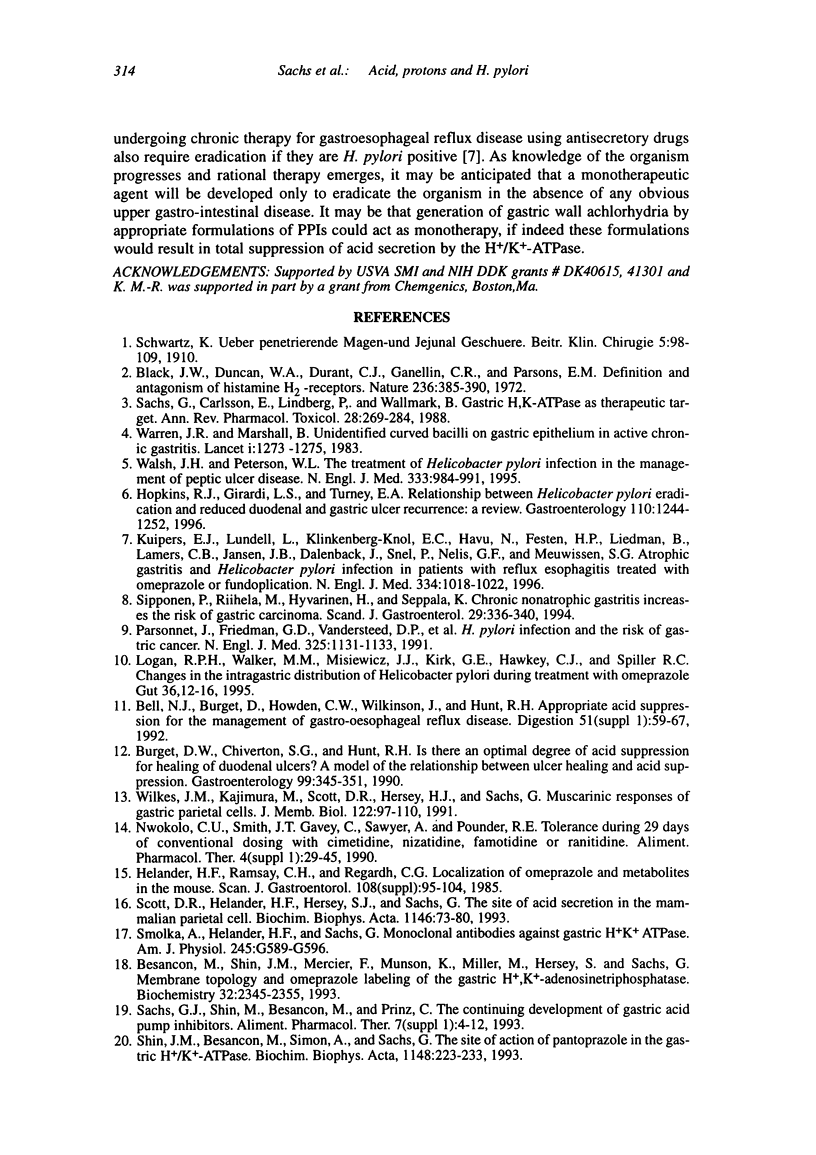
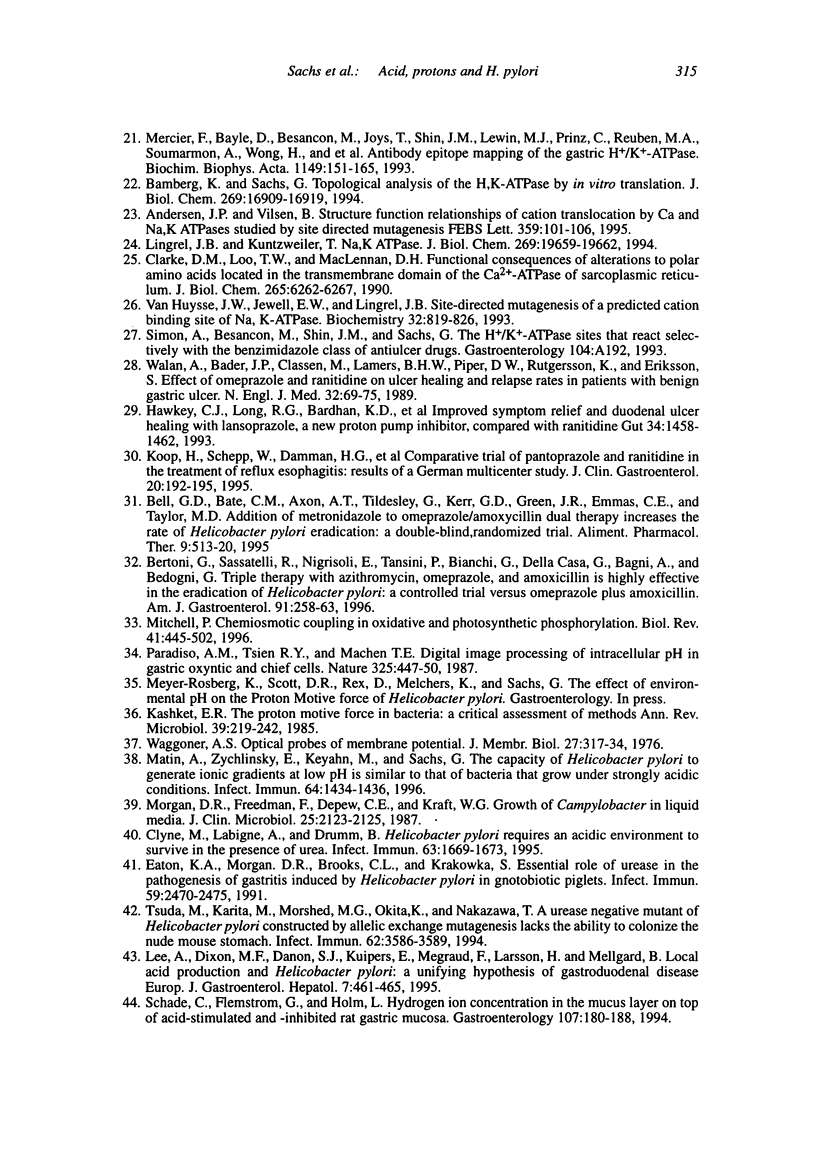
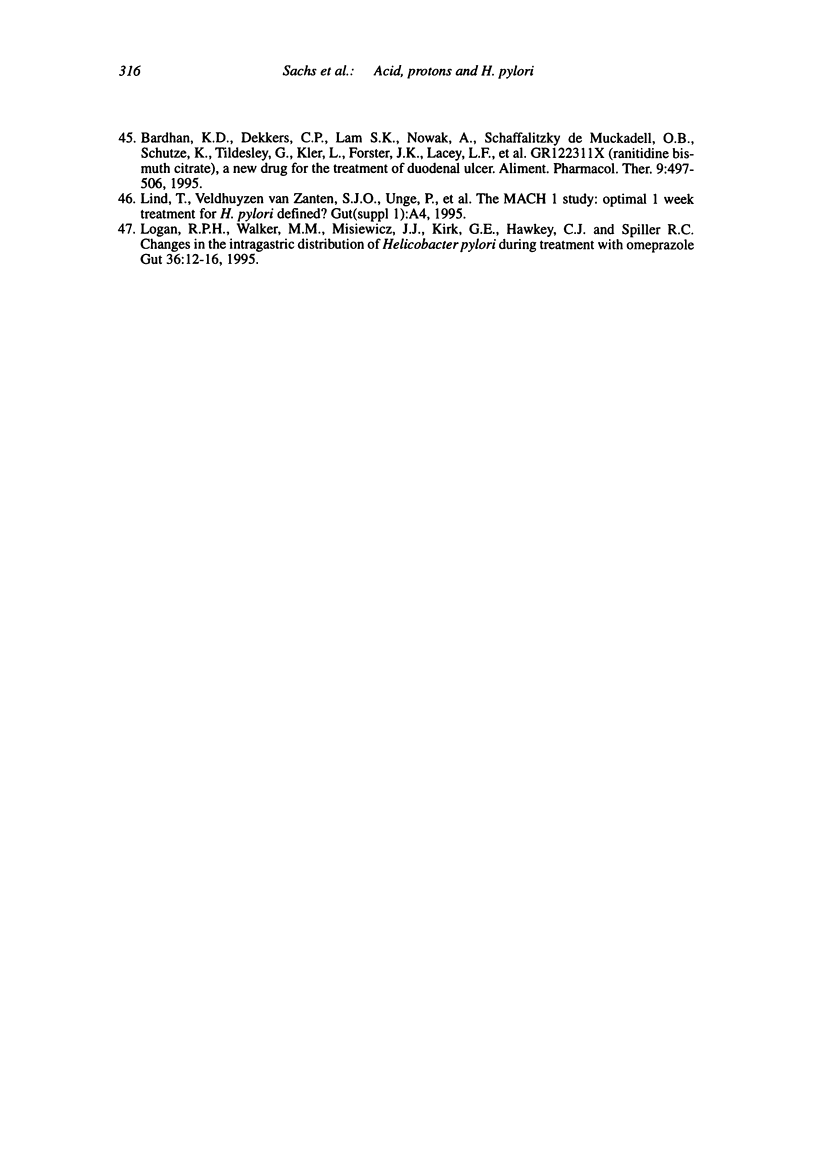
Images in this article
Selected References
These references are in PubMed. This may not be the complete list of references from this article.
- Andersen J. P., Vilsen B. Structure-function relationships of cation translocation by Ca(2+)- and Na+, K(+)-ATPases studied by site-directed mutagenesis. FEBS Lett. 1995 Feb 13;359(2-3):101–106. doi: 10.1016/0014-5793(95)00019-6. [DOI] [PubMed] [Google Scholar]
- Bamberg K., Sachs G. Topological analysis of H+,K(+)-ATPase using in vitro translation. J Biol Chem. 1994 Jun 17;269(24):16909–16919. [PubMed] [Google Scholar]
- Bardhan K. D., Dekkers C. P., Lam S. K., Nowak A., Schaffalitzky de Muckadell O. B., Schutze K., Tildesley G., Kler L., Forster J. K., Lacey L. F. GR122311X (ranitidine bismuth citrate), a new drug for the treatment of duodenal ulcer. Aliment Pharmacol Ther. 1995 Oct;9(5):497–506. doi: 10.1111/j.1365-2036.1995.tb00412.x. [DOI] [PubMed] [Google Scholar]
- Bell G. D., Bate C. M., Axon A. T., Tildesley G., Kerr G. D., Green J. R., Emmas C. E., Taylor M. D. Addition of metronidazole to omeprazole/amoxycillin dual therapy increases the rate of Helicobacter pylori eradication: a double-blind, randomized trial. Aliment Pharmacol Ther. 1995 Oct;9(5):513–520. doi: 10.1111/j.1365-2036.1995.tb00414.x. [DOI] [PubMed] [Google Scholar]
- Bell N. J., Burget D., Howden C. W., Wilkinson J., Hunt R. H. Appropriate acid suppression for the management of gastro-oesophageal reflux disease. Digestion. 1992;51 (Suppl 1):59–67. doi: 10.1159/000200917. [DOI] [PubMed] [Google Scholar]
- Bertoni G., Sassatelli R., Nigrisoli E., Tansini P., Bianchi G., Della Casa G., Bagni A., Bedogni G. Triple therapy with azithromycin, omeprazole, and amoxicillin is highly effective in the eradication of Helicobacter pylori: a controlled trial versus omeprazole plus amoxicillin. Am J Gastroenterol. 1996 Feb;91(2):258–263. [PubMed] [Google Scholar]
- Besancon M., Shin J. M., Mercier F., Munson K., Miller M., Hersey S., Sachs G. Membrane topology and omeprazole labeling of the gastric H+,K(+)-adenosinetriphosphatase. Biochemistry. 1993 Mar 9;32(9):2345–2355. doi: 10.1021/bi00060a028. [DOI] [PubMed] [Google Scholar]
- Black J. W., Duncan W. A., Durant C. J., Ganellin C. R., Parsons E. M. Definition and antagonism of histamine H 2 -receptors. Nature. 1972 Apr 21;236(5347):385–390. doi: 10.1038/236385a0. [DOI] [PubMed] [Google Scholar]
- Burget D. W., Chiverton S. G., Hunt R. H. Is there an optimal degree of acid suppression for healing of duodenal ulcers? A model of the relationship between ulcer healing and acid suppression. Gastroenterology. 1990 Aug;99(2):345–351. doi: 10.1016/0016-5085(90)91015-x. [DOI] [PubMed] [Google Scholar]
- Clarke D. M., Loo T. W., MacLennan D. H. Functional consequences of alterations to polar amino acids located in the transmembrane domain of the Ca2(+)-ATPase of sarcoplasmic reticulum. J Biol Chem. 1990 Apr 15;265(11):6262–6267. [PubMed] [Google Scholar]
- Clyne M., Labigne A., Drumm B. Helicobacter pylori requires an acidic environment to survive in the presence of urea. Infect Immun. 1995 May;63(5):1669–1673. doi: 10.1128/iai.63.5.1669-1673.1995. [DOI] [PMC free article] [PubMed] [Google Scholar]
- Eaton K. A., Brooks C. L., Morgan D. R., Krakowka S. Essential role of urease in pathogenesis of gastritis induced by Helicobacter pylori in gnotobiotic piglets. Infect Immun. 1991 Jul;59(7):2470–2475. doi: 10.1128/iai.59.7.2470-2475.1991. [DOI] [PMC free article] [PubMed] [Google Scholar]
- Hawkey C. J., Long R. G., Bardhan K. D., Wormsley K. G., Cochran K. M., Christian J., Moules I. K. Improved symptom relief and duodenal ulcer healing with lansoprazole, a new proton pump inhibitor, compared with ranitidine. Gut. 1993 Oct;34(10):1458–1462. doi: 10.1136/gut.34.10.1458. [DOI] [PMC free article] [PubMed] [Google Scholar]
- Helander H. F., Ramsay C. H., Regårdh C. G. Localization of omeprazole and metabolites in the mouse. Scand J Gastroenterol Suppl. 1985;108:95–104. doi: 10.3109/00365528509095822. [DOI] [PubMed] [Google Scholar]
- Hopkins R. J., Girardi L. S., Turney E. A. Relationship between Helicobacter pylori eradication and reduced duodenal and gastric ulcer recurrence: a review. Gastroenterology. 1996 Apr;110(4):1244–1252. doi: 10.1053/gast.1996.v110.pm8613015. [DOI] [PubMed] [Google Scholar]
- Koop H., Schepp W., Dammann H. G., Schneider A., Lühmann R., Classen M. Comparative trial of pantoprazole and ranitidine in the treatment of reflux esophagitis. Results of a German multicenter study. J Clin Gastroenterol. 1995 Apr;20(3):192–195. doi: 10.1097/00004836-199504000-00005. [DOI] [PubMed] [Google Scholar]
- Kuipers E. J., Lundell L., Klinkenberg-Knol E. C., Havu N., Festen H. P., Liedman B., Lamers C. B., Jansen J. B., Dalenback J., Snel P. Atrophic gastritis and Helicobacter pylori infection in patients with reflux esophagitis treated with omeprazole or fundoplication. N Engl J Med. 1996 Apr 18;334(16):1018–1022. doi: 10.1056/NEJM199604183341603. [DOI] [PubMed] [Google Scholar]
- Lee A., Dixon M. F., Danon S. J., Kuipers E., Mégraud F., Larsson H., Mellgård B. Local acid production and Helicobacter pylori: a unifying hypothesis of gastroduodenal disease. Eur J Gastroenterol Hepatol. 1995 May;7(5):461–465. [PubMed] [Google Scholar]
- Lingrel J. B., Kuntzweiler T. Na+,K(+)-ATPase. J Biol Chem. 1994 Aug 5;269(31):19659–19662. [PubMed] [Google Scholar]
- Logan R. P., Walker M. M., Misiewicz J. J., Gummett P. A., Karim Q. N., Baron J. H. Changes in the intragastric distribution of Helicobacter pylori during treatment with omeprazole. Gut. 1995 Jan;36(1):12–16. doi: 10.1136/gut.36.1.12. [DOI] [PMC free article] [PubMed] [Google Scholar]
- Logan R. P., Walker M. M., Misiewicz J. J., Gummett P. A., Karim Q. N., Baron J. H. Changes in the intragastric distribution of Helicobacter pylori during treatment with omeprazole. Gut. 1995 Jan;36(1):12–16. doi: 10.1136/gut.36.1.12. [DOI] [PMC free article] [PubMed] [Google Scholar]
- Matin A., Zychlinsky E., Keyhan M., Sachs G. Capacity of Helicobacter pylori to generate ionic gradients at low pH is similar to that of bacteria which grow under strongly acidic conditions. Infect Immun. 1996 Apr;64(4):1434–1436. doi: 10.1128/iai.64.4.1434-1436.1996. [DOI] [PMC free article] [PubMed] [Google Scholar]
- Mercier F., Bayle D., Besancon M., Joys T., Shin J. M., Lewin M. J., Prinz C., Reuben M. A., Soumarmon A., Wong H. Antibody epitope mapping of the gastric H+/K(+)-ATPase. Biochim Biophys Acta. 1993 Jun 18;1149(1):151–165. doi: 10.1016/0005-2736(93)90036-y. [DOI] [PubMed] [Google Scholar]
- Mitchell P. Chemiosmotic coupling in oxidative and photosynthetic phosphorylation. Biol Rev Camb Philos Soc. 1966 Aug;41(3):445–502. doi: 10.1111/j.1469-185x.1966.tb01501.x. [DOI] [PubMed] [Google Scholar]
- Morgan D. R., Freedman R., Depew C. E., Kraft W. G. Growth of Campylobacter pylori in liquid media. J Clin Microbiol. 1987 Nov;25(11):2123–2125. doi: 10.1128/jcm.25.11.2123-2125.1987. [DOI] [PMC free article] [PubMed] [Google Scholar]
- Nwokolo C. U., Smith J. T., Gavey C., Sawyerr A., Pounder R. E. Tolerance during 29 days of conventional dosing with cimetidine, nizatidine, famotidine or ranitidine. Aliment Pharmacol Ther. 1990;4 (Suppl 1):29–45. [PubMed] [Google Scholar]
- Paradiso A. M., Tsien R. Y., Machen T. E. Digital image processing of intracellular pH in gastric oxyntic and chief cells. 1987 Jan 29-Feb 4Nature. 325(6103):447–450. doi: 10.1038/325447a0. [DOI] [PubMed] [Google Scholar]
- Parsonnet J., Friedman G. D., Vandersteen D. P., Chang Y., Vogelman J. H., Orentreich N., Sibley R. K. Helicobacter pylori infection and the risk of gastric carcinoma. N Engl J Med. 1991 Oct 17;325(16):1127–1131. doi: 10.1056/NEJM199110173251603. [DOI] [PubMed] [Google Scholar]
- Sachs G., Carlsson E., Lindberg P., Wallmark B. Gastric H,K-ATPase as therapeutic target. Annu Rev Pharmacol Toxicol. 1988;28:269–284. doi: 10.1146/annurev.pa.28.040188.001413. [DOI] [PubMed] [Google Scholar]
- Sachs G., Shin J. M., Besancon M., Prinz C. The continuing development of gastric acid pump inhibitors. Aliment Pharmacol Ther. 1993;7 (Suppl 1):4-12, discussion 29-31. doi: 10.1111/j.1365-2036.1993.tb00582.x. [DOI] [PubMed] [Google Scholar]
- Schade C., Flemström G., Holm L. Hydrogen ion concentration in the mucus layer on top of acid-stimulated and -inhibited rat gastric mucosa. Gastroenterology. 1994 Jul;107(1):180–188. doi: 10.1016/0016-5085(94)90075-2. [DOI] [PubMed] [Google Scholar]
- Scott D. R., Helander H. F., Hersey S. J., Sachs G. The site of acid secretion in the mammalian parietal cell. Biochim Biophys Acta. 1993 Feb 23;1146(1):73–80. doi: 10.1016/0005-2736(93)90340-6. [DOI] [PubMed] [Google Scholar]
- Shin J. M., Besancon M., Simon A., Sachs G. The site of action of pantoprazole in the gastric H+/K(+)-ATPase. Biochim Biophys Acta. 1993 Jun 5;1148(2):223–233. doi: 10.1016/0005-2736(93)90133-k. [DOI] [PubMed] [Google Scholar]
- Sipponen P., Riihelä M., Hyvärinen H., Seppälä K. Chronic nonatropic ('superficial') gastritis increases the risk of gastric carcinoma. A case-control study. Scand J Gastroenterol. 1994 Apr;29(4):336–340. doi: 10.3109/00365529409094845. [DOI] [PubMed] [Google Scholar]
- Tsuda M., Karita M., Morshed M. G., Okita K., Nakazawa T. A urease-negative mutant of Helicobacter pylori constructed by allelic exchange mutagenesis lacks the ability to colonize the nude mouse stomach. Infect Immun. 1994 Aug;62(8):3586–3589. doi: 10.1128/iai.62.8.3586-3589.1994. [DOI] [PMC free article] [PubMed] [Google Scholar]
- Unidentified curved bacilli on gastric epithelium in active chronic gastritis. Lancet. 1983 Jun 4;1(8336):1273–1275. [PubMed] [Google Scholar]
- Van Huysse J. W., Jewell E. A., Lingrel J. B. Site-directed mutagenesis of a predicted cation binding site of Na, K-ATPase. Biochemistry. 1993 Jan 26;32(3):819–826. doi: 10.1021/bi00054a012. [DOI] [PubMed] [Google Scholar]
- Waggoner A. Optical probes of membrane potential. J Membr Biol. 1976 Jun 30;27(4):317–334. doi: 10.1007/BF01869143. [DOI] [PubMed] [Google Scholar]
- Walan A., Bader J. P., Classen M., Lamers C. B., Piper D. W., Rutgersson K., Eriksson S. Effect of omeprazole and ranitidine on ulcer healing and relapse rates in patients with benign gastric ulcer. N Engl J Med. 1989 Jan 12;320(2):69–75. doi: 10.1056/NEJM198901123200201. [DOI] [PubMed] [Google Scholar]
- Walsh J. H., Peterson W. L. The treatment of Helicobacter pylori infection in the management of peptic ulcer disease. N Engl J Med. 1995 Oct 12;333(15):984–991. doi: 10.1056/NEJM199510123331508. [DOI] [PubMed] [Google Scholar]
- Wilkes J. M., Kajimura M., Scott D. R., Hersey S. J., Sachs G. Muscarinic responses of gastric parietal cells. J Membr Biol. 1991 Jun;122(2):97–110. doi: 10.1007/BF01872634. [DOI] [PubMed] [Google Scholar]







